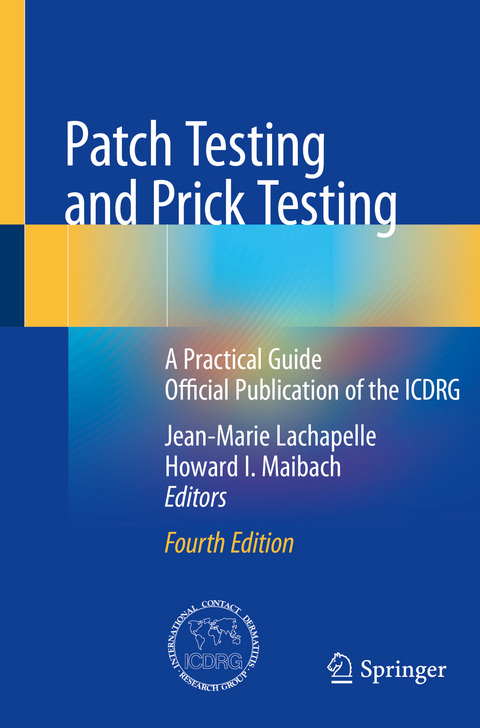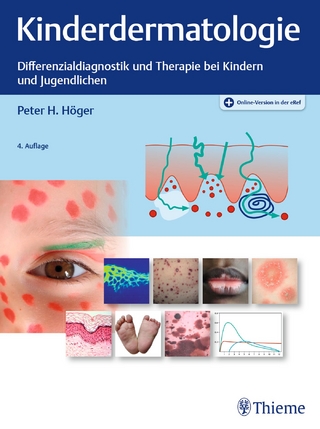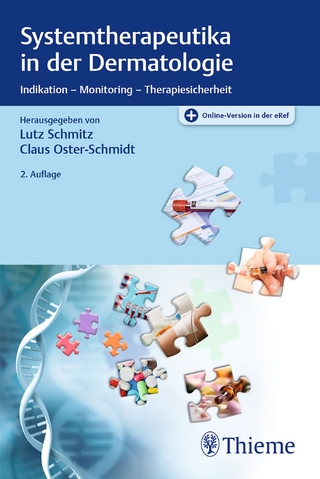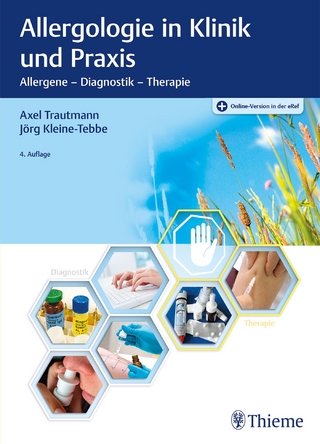
Patch Testing and Prick Testing
Springer International Publishing (Verlag)
978-3-030-27101-5 (ISBN)
The fourth edition continues the tradition of partnering with the ICDRG (International Contact Dermatitis Research Group). The ICDRG was formed in 1966 to promote the understanding of contact dermatitis. It has had major roles in the standardization of patch testing and the facilitation of regular scientific meetings, for over forty years and thirty five years respectively. It has also been involved in the authorship of a number of publications on contact dermatitis. Both Drs. Maibach and Lachapelle are members and the ICDRG is now comprised of representatives from all over the world, and currently includes members from Belgium, Sweden, Denmark, the United Kingdom, USA, Germany, Singapore, Korea, India, Japan, Canada, Uruguay and Australia.
From the reviews of the previous editions:"The aim is to balance brevity and clarity with sufficient details for beginners in the field of diagnostic patch and prick testing. ... the book also will be of use to dermatology residents or anyone wishing to gain better knowledge of contact dermatitis. ... There are many high-quality photographs and useful algorithms and tables. ... It is clearly and concisely written and will serve as an indispensable guide for any dermatologist interested in contact dermatitis." (Renata H. Mullen, Doody's Review Service, August, 2009)
lt;b>Jean-Marie Lachapelle is Professor Emeritus in the Department of Dermatology at Université Catholique de Louvain in Belgium. He is one of the foremost experts in patch testing and contact dermatitis.
Howard Maibach, MD is an expert in contact and occupational dermatitis and sees patient at the Environmental Dermatosis Clinic, which is part of the Dermatology Clinic. His specialty is dermatotoxicology, or skin exposure toxicity; allergies and skin disorders; and dermatopharmacology or the study of medications for skin disorders. Dr. Maibach has been on the editorial board of more than 30 scientific journals and is a member of 19 professional societies, including the American Academy of Dermatology, San Francisco Dermatological Society and the Internal Commission on Occupation Health. He is a professor in the Department of Dermatology at UCSF.
Contents
Introductory Remarks
Part I Patch Testing1 Pathophysiology of Allergic and Irritant Contact Dermatitis1.1 Introduction1.2 Pathophysiology of Irritant and Allergic Skin Inflammation1.2.1 Irritant and/or Allergic Chemicals1.2.2 Skin Irritation: Activation of Innate Immunity1.3 Skin Allergy: The Role of Specific Immunity1.3.1 Antigen-Specific Immunity1.3.2 Skin Allergy: Mechanisms of Action1.3.3 Indirect Responsibility of Chemicals in Skin Irritation1.4 Pathophysiology of Skin Inflammation: The Connection Between Innate and Acquired ImmunityReferences2 Diseases for Which Patch Testing Is Recommended: Patients Who Should Be Investigated2.1 Allergic Contact Dermatitis2.1.1 Clinical Signs and Symptoms2.1.2 Histopathological Features2.2 Allergic Contact Dermatitis Syndrome2.2.1 Stage 1 of ACDS2.2.2 Stage 2 of ACDS2.2.3 Stage 3 of ACDS2.3 Allergic Contact Dermatitis Versus Irritant Contact Dermatitis: Criteria for Differential Diagnosis2.4 Other Skin Diseases in Which Patch Testing Is of Major Interest2.5 Algorithmic Approach: Key Role of Patch Testing2.6 Hand Dermatitis: Definition and Procedures Applied in Differential Diagnosis2.6.1 Hand Dermatitis: Exogenous and Endogenous Factors2.6.2 A Classification of Hand Dermatitis2.6.3 Tools of Investigation2.6.4 Hand Dermatitis: Some Examples of an Algorithmic Approach2.6.5 Hand Eczema: A Controversial IssueReferences3 Patch Testing Methodology3.1 Historical Background3.2 Definition and Aims3.2.1 Requirements for an Ideal Patch Testing Procedure3.2.2 Is Patch Testing the "Gold Standard" to Investigate Patients with Allergic Contact Dermatitis?3.3 Patch Test Units3.3.1 Nonchamber Patch Tests3.3.2 Chamber Patch Tests3.3.3 Plastic Square Chambers3.3.4 Reinforcement of Patch Test Units3.4 A General Overview of Allergens3.4.1 Allergens3.4.2 Bioavailability of Allergens3.4.3 Quality Control of Allergens3.4.4 Appropriate Amounts of Petrolatum to Be Applied at Patch Testing3.4.5 Appropriate Amounts of Liquids to Be Applied at Patch Testing3.5 Specific Recommendations When Considering Patch Testing Patients3.5.1 Patch Testing on Intact Skin Is Critical3.5.2 Medicaments and Patch Testing3.5.3 Pregnancy and Patch Testing3.5.4 Patch Testing in Children3.6 Application of Patch Tests on the Skin: Some Practical Suggestions3.6.1 Test Sites3.6.2 Removal of Hair3.6.3 Degreasing of Test Site3.6.4 Application of Test Strips3.6.5 Instructions to Patients3.7 Reading Time3.7.1 Standard Patch Test Occlusion and Reading Time3.7.2 Conventional Patch Test Reading Time3.7.3 Reading at Day 2, Day 3, and Day 43.7.4 Reading at Day 73.7.5 Single Reading Versus Multiple Reading3.7.6 Day 3 Versus Day 4 Reading3.7.7 One-Day Occlusion Versus Two-Day Occlusion3.7.8 Marking the Skin3.7.9 Positive Control3.7.10 Immediate Urticarial Reactions to Some Allergens3.8 Reading and Scoring Patch Test Results3.8.1 Scoring Codes According to the ICDRG3.8.2 Proposal for Modified Scoring Codes of Positive Patch Test Reactions, According to ESCD and EECDRG3.8.3 Rating Patch Test Reactions Based on Digital Images3.8.4 Bioengineering Methods for Evaluating Skin Irritation and Allergic Reactions. A Comparison with Visual Scoring3.8.5 Remarks About Reading and Scoring Patch Test Results3.9 Irritant Patch Test Reactions3.10 False-Positive Patch Test Reactions3.11 False-Negative Patch Test Reactions3.12 Compound Allergy3.13 Cross-Sensitization, Concomitant Sensitization, and Polysensitization3.13.1 Cross-Sensitization3.13.2 Concomitant Sensitization3.13.3 Polysensitization3.14 Unwanted Adverse Reactions of Patch Testing3.14.1 Patch Test Sensitization ("Active Sensitization")3.14.2 Excited Skin Syndrome ("Angry Back")3.15 Patch Test Readings in Different Ethnic Populations3.15.1 Patch Test Reading in Oriental Populations3.15.2 Patch Test Reading in Black Populations3.16 Patch Testing Techniques in Different Climatic Environments3.16.1 Temperate Climates3.16.2 Tropical Climates3.16.3 Patch Testing Procedures in the Tropics3.17 Is Self-assessment of Allergic Contact Dermatitis by Patients Recommendable?3.17.1 Self-assessment by Questionnaires3.17.2 Self-readings of Patch Tests by PatientsReferences4 Baseline Series of Patch Tests4.1 Historical Background4.2 Advantages and Disadvantages of Using a Baseline Series of Patch Tests4.2.1 Advantages4.2.2 Disadvantages4.3 The Different Baseline Series of Patch Tests4.3.1 ICDRG-Revised International Minimal Baseline Series of Patch Tests4.3.2 The Updated 2019 European Baseline Series on Behalf of the ESCD and EECDRG4.3.3 The Updated 20109 North American Baseline Series on Behalf of the NACDG4.3.4 The Updated 2019 Japanese Baseline Series on Behalf of the JCDS4.4 "Mixes" of Baseline Series4.5 Concise Information About Allergens Included in the Updated 2011 Minimal Baseline Series of the ICDRG4.6 Concise Information on Other Common Allergens Included in the Updated 2011 Minimal Baseline Series of the ICDRG4.7Additional Series of Patch Tests4.8 The Preservative Methylisothiazolinone : The New Star of Allergic Contact DermatitisReferences5 Photopatch Testing5.1 Definition and Aims5.2 Photoallergic Contact Dermatitis5.3 Photoallergic Contact Dermatitis Versus Airborne Allergic Contact Dermatitis: Criteria for Differential Diagnosis5.4 Photoallergic Drug Eruptions5.5 Photopatch Testing Methodology5.6 Light Sources5.7 Proposal for a Photopatch Test SeriesReferences6 The T.R.U.E. Test® Methodology6.1 Introduction6.2 The T.R.U.E. Test® Methodology6.3 More Practical Information About the Technology of The T.R.U.E. Test®6.4 Regulatory Information6.5 Standard The T.R.U.E. Test® Series6.6 New Additions6.7 Methodology of Use6.8 Additional Information6.9 NoteReferences7 Additional Testing Procedures and Spot Tests7.1 Strip Patch Test7.2 Open Test7.3 Semi-open (or Semi-occlusive) Tests7.4 Repeated Open Application Test7.5 Testing Procedures with Unknown Substances7.5.1 Strategy7.5.2 Steps Required Prior to Any Testing Procedure7.5.3 Testing Procedures with Solid Products and Extracts7.5.4 The Use of Ultrasonic Bath Extracts in the Search of the Culprit(s) Allergen(s) present in Solid Products7.5.5 Testing Procedures with Cosmetics and Other Related Products7.6 Oral Provocation Test (Oral Challenge)7.7 Other Investigations7.7.1 pH Measurement7.7.2 Spot Tests7.7.3 Chemical Analysis7.8 Additional Remarks About Chemistry and Immunology in Relationship with Allergic Contact DermatitisReferences8 Clinical Relevance of Patch Test Reactions8.1 Introduction8.2 General Principles8.3 Past and Current Relevance8.4 Scoring System8.5 Strategies8.5.1 Clinical History8.5.2 Environmental Evaluation8.5.3 Further Correlations8.5.4 Additional Investigations8.6 Suggestions for Improved Evidence-Based Diagnosis of Relevance8.7 Additional RemarkReferences9 Atopic Dermatitis, Irritant Contact Dermatitis, and Allergic Contact Dermatitis9.1 Preliminary Remarks9.2 Etiopathogenic Advances9.3 Disruption of the Skin Barrier9.4 Increased Disruption of the Skin Barrier in AD9.5 Hand Eczema9.6 Other Skin Typical Locations of Lesions in AD9.7 Guidelines for the Practice of Patch TestingReferencesPart II Prick Testing10 Spectrum of Diseases for Which Prick Testing and Open (Non-prick) Testing Are Recommended: Patients Who Should Be Investigated10.1 Contact Urticaria Syndrome10.1.1 Clinical Symptoms and Stages of CUS10.1.2 Etiology and Mechanisms of CUS10.1.3 Contact Urticaria to Natural Rubber Latex10.2 Protein Contact DermatitisReferences11 Methodology of Open (Non-prick) Testing, Prick Testing, and Its Variants11.1 Introductory Remarks11.2 Open (Non-prick) Testing11.3 Prick Test: Technical Modalities and Reading11.3.1 Technique of Puncture11.3.2 Control Solutions11.3.3 Reading Time11.3.4 Reading Prick Test Results11.3.5 Medicaments and Prick Testing11.3.6 False-Negative Reactions11.3.7 False-Positive Reactions11.3.8 Prick Tests in Children and Babies11.4 Prick-by-Prick Test11.5 Scratch Test11.5 Scratch-Chamber Test11.7 Comparative Indications of Open (Non-prick) Testing, Prick Testing, and Other Related Tests11.8 Intradermal Testing for Type 1 Hypersensitivity11.9 Prick Testing: Allergens of Interest for Skin Problems11.9.1 Latex11.9.2 Airborne Environmental per Annum Allergens11.9.3 Airborne Environmental Seasonal Allergens11.9.4 Food Allergens (Trophallergens)11.9.5 Occupational Allergens11.9.6 Fungi11.9.7 Miscellaneous (Immunological and/or Non-immunological) UrticariogensReferencesPart III Testing in Cutaneous Systemic Immune-Related Adverse Drug Reactions: Interest and Limitations12 Testing Procedures in Cutaneous Systemic Immune-Related Adverse Drug Reactions12.1 General Considerations12.2 Proposal of a Classification of CADR12.3 Tools of Investigation in CADR12.4 Histopathological Limitations in Diagnosis of a CADR12.5 Patch Testing in CADR12.5.1 Spectrum of CADRs for Which Patch Testing Is Recommended12.5.2 Spectrum of CADRs for Which Patch Testing Can Be Performed (Being Still Controversial)12.5.3 Spectrum of CADRs for Which Patch Testing Is of No Interest12.5.4 Guidelines in Drug Patch Testing: General Rules12.5.5 Technical Aspects of Drug Patch Testing12.5.6 Readings of Drug Patch Tests12.5.7 False-Negative Patch Test Reactions12.5.8 False-Positive Patch Test Reactions12.6 Prick Testing in CADR12.7 Intradermal Testing in CADR12.8 Oral Provocation Test (Oral Challenge) in CADRReferencesAppendicesAppendix A: Additional Series of Patch TestsA.1 Introductory RemarksA.2 Bakery SeriesA.3 Corticosteroid SeriesA.4 Cosmetic SeriesA.5 Epoxy Resin SeriesA.6 Hairdressing SeriesA.7 Isocyanate SeriesA.8 Metal SeriesA.9 (Meth)Acrylate SeriesA.10 Plastics and Glues SeriesA.11 Rubber Additives SeriesA.12 Textile Dyes and Finish SeriesA.13 Other SeriesReferencesAppendix B: The International Contact Dermatitis Research GroupB.1 Historical BackgroundB.2 Current Tasks and Strategy of the ICDRGB.3 ICDRG MembersReferencesAppendix C: A List of Companies Producing and/or Distributing Patch and/or Prick Test Materials and/or AllergensC.1 Introductory RemarksC.2 List of Companies
"The book is written for any medical practitioners interested in contact dermatitis, but dermatologists and allergists will find it most useful. The book meets the needs of this intended audience. ... I highly recommend this up dated edition as there have been many breakthroughs since the last edition was published in 2012. Happy reading!" (Renata H. Mullen, Doody's Book Reviews, April 3, 2020)
| Erscheinungsdatum | 05.01.2021 |
|---|---|
| Zusatzinfo | XXII, 246 p. 98 illus., 93 illus. in color. |
| Verlagsort | Cham |
| Sprache | englisch |
| Maße | 155 x 235 mm |
| Gewicht | 459 g |
| Themenwelt | Medizin / Pharmazie ► Medizinische Fachgebiete ► Dermatologie |
| Schlagworte | allergic contact dermatitis • Drug-induced Skin Reactions • Irritant Contact Dermatitis • patch testing • Prick Testing |
| ISBN-10 | 3-030-27101-3 / 3030271013 |
| ISBN-13 | 978-3-030-27101-5 / 9783030271015 |
| Zustand | Neuware |
| Informationen gemäß Produktsicherheitsverordnung (GPSR) | |
| Haben Sie eine Frage zum Produkt? |
aus dem Bereich


